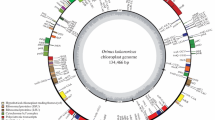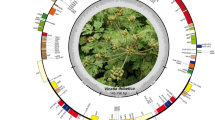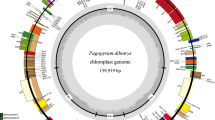Abstract
Cinnamomum daphnoides (Siebold & Zucc 1846) is a rare and endangered island species with a unique Sino-Japanese distribution pattern. However, inormation regarding the species’ chloroplast (cp) genome, structural features, and the phylogenetic relationship is still lacking. We utilized high-throughput sequencing technology to assemble and annotate the first cp genome of C. daphnoides (GenBank OR654104), followed by genomic characterization and phylogenetic analysis to fill the gaps in this species’ cp genome. Our analysis showed that the cp genome has a quadripartite structure spanning 152,765 bp with a GC content of 39.15%. The genome encodes 126 genes, which include 36 tRNA genes, 8 rRNA genes, and 82 mRNA genes. Specifically, 44 genes are related to photosynthesis, 59 are associated with self-replication, six are other genes, and four have unknown functionality. The Codon usage bias in the genome exhibits a preference for A/U bases. We identified 29 interspaced repeat sequences that belonging to three types of repeat sequences. A total of 217 cpSSR loci were detected with single nucleotide repeats (59.91%) being the most frequent loci, mainly composed of A/T repeats. Our selection pressure analysis revealed that the ycf2 gene experienced strong positive selection (Ka/Ks = 1.81, P > 0.844). Further, we identified three highly variable fragments (psbM, psbT, and ycf1) that can be utilized as specific DNA barcoding markers for species definition and population genetic studies. We conducted boundary analysis, which showed that the structure and gene sequence of the two species were highly conserved. Finally, our phylogenetic analysis supports that C. daphnoides is close to C. cassia in the Cinnamomum genes, indicating that the two species share a common ancestry. Overall, providing genomic information on C. daphnoides will be beneficial for the conservation and utilization of endangered plant genetic resources. It will also serve as a reference for the identification of species and the phylogenetic analysis of Cinnamomum. This information will be useful in future research.








Similar content being viewed by others
Data Availability
The genome sequence data that support the findings of this study are openly available in GenBank of NCBI at https://www.ncbi.nlm.nih.gov under accession no. OR654104.
References
Nitta, I., & Ohsawa, M. (2001). Geographical transition of sylleptic/proleptic branching in three Cinnamomum species with different bud types. Annals of Botany, 87(1), 35–45.
Akiyama, S., Thijsse, G., Esser, H. J., & Ohba, H. (2014). Siebold and Zuccarini’s type specimens and original materials from Japan, Part 3. Angiosperms. Dicotyledoneae 2. Journal of Japanese Botany, 89(2), 76–102.
Kakishima, M., Ji, J. X., Nagao, H., Wang, Q., & Denchev, C. M. (2017). Clinoconidium globosum, nom. Nov. (Cryptobasidiaceae) producing galls on shoot buds of Cinnamomum tenuifolium in Japan. Phytotaxa, 299(2), 267–272.
Zhang, Y. F., Li, X. P., Chen, Z. H., Zhu, Z. X., Zhang, F. Y., Ma, D. D., & Li, G. Y. (2014). A newly recorded species of Lauraceae from China: Cinnamomum daphnoides Sieb et Zucc. Journal of Tropical and Subtropical Botany, 22(5), 453–455. (in Chinese with English abstract).
Fujita, Y., Fujita, S. I., & Yoshikawa, H. (1970). Biogenesis of the essential oils in camphor trees-26-on the components of the essential oil of Cinnamomum daphnoides Sieb, et Zucc. Bulletin of the Chemical Society of Japan, 43(8), 2630–2631.
Neuhaus, H. E., & Emes, M. J. (2000). Nonphotosynthetic metabolism in plastids. Annual Review of Plant Biology, 51(1), 111–140.
Olejniczak, S. A., Łojewska, E., Kowalczyk, T., & Sakowicz, T. (2016). Chloroplasts: State of research and practical applications of plastome sequencing. Planta, 244, 517–527.
Li, X., Li, Y., Zang, M., Li, M., & Fang, Y. (2018). Complete chloroplast genome sequence and phylogenetic analysis of Quercus acutissima. International Journal of Molecular Sciences, 19(8), 1–17.
Li, Y., Sylveter, S. P., Li, M., Zhang, C., Li, X., Duan, Y., & Wang, X. (2019). The complete plastid genome of Magnolia zenii and genetic comparison to Magnoliaceae species. Molecules, 24(2), 261.
Hou, Z., Wang, Z., & Zhang, J. (2020). The complete chloroplast genomic landscape and phylogenetic analyses of Populus alba L. Journal of Forestry Research, 31(5), 1875–1879.
Yang, X., Zhou, T., Su, X., Wang, G., Zhang, X., Guo, Q., & Cao, F. (2021). Structural characterization and comparative analysis of the chloroplast genome of Ginkgo biloba and other gymnosperms. Journal of Forestry Research, 32, 765–778.
Wu, J., Zhang, J., Guo, X., Yu, N., Peng, D., & Xing, S. (2023). Comprehensive analysis of complete chloroplast genome sequence of Plantago asiatica L. (Plantaginaceae). Plant Signaling & Behavior, 18(1), 2163345.
Andrews, S. (2010). FastQC: A quality control tool for high throughput sequence data. Available online. Retrieved May 17, 2018
Bankevich, A., Nurk, S., Antipov, D., Gurevich, A. A., Dvorkin, M., Kulikov, A. S., Lesin, V. M., Nikolenko, S. I., Pham, S., Prjibelski, A. D., Pyshkin, A. V., Vyahhi, N., Tesler, G., Alekseyev, M. A., & Pevzner, P. A. (2012). SPAdes: A new genome assembly algorithm and its applications to single-cell sequencing. Journal of Computational Biology, 19(5), 455–477.
Greiner, S., Lehwark, P., & Bock, R. (2019). OrganellarGenomeDRAW (OGDRAW) version 1.31: Expanded toolkit for the graphical visualization of organellar genomes. Nucleic Acids Research, 47(W1), W59–W64.
Sharp, P. M., Tuohy, T. M., & Mosurski, K. R. (1986). Codon usage in yeast: Cluster analysis clearly differentiates highly and lowly expressed genes. Nucleic Acids Research, 14(13), 5125–5143.
Beier, S., Thiel, T., Münch, T., Scholz, U., & Mascher, M. (2017). MISA-web: A web server for microsatellite prediction. Bioinformatics, 33(16), 2583–2585.
Katoh, K., Rozewicki, J., & Yamada, K. D. (2019). MAFFT online service: Multiple sequence alignment, interactive sequence choice and visualization. Briefings in Bioinformatics, 20(4), 1160–1166.
Librado, P., & Rozas, J. (2009). DnaSP v5: A software for comprehensive analysis of DNA polymorphism data. Bioinformatics, 25(11), 1451–1452.
Stamatakis, A. (2014). RAxML version 8: A tool for phylogenetic analysis and post-analysis of large phylogenies. Bioinformatics, 30(9), 1312–1313.
Wang, N., Chen, S., Xie, L., Wang, L., Feng, Y., Lv, T., Fang, Y., & Ding, H. (2022). The complete chloroplast genomes of three Hamamelidaceae species: Comparative and phylogenetic analyses. Ecology and Evolution, 12(2), e8637.
Smith, D. R. (2017). Does cell size impact chloroplast genome size? Frontiers in Plant Science, 8, 2116.
Zhao, Y., Yang, Z., Zhao, Y., Li, X., Zhao, Z., & Zhao, G. (2019). Chloroplast genome structural characteristics and phylogenetic relationships of Oleaceae. Chinese Bulletin of Botany, 54(4), 441–454. (in Chinese with English abstract).
Chen, C., Zheng, Y., Liu, S., Zhong, Y., Wu, Y., Li, J., Xu, L., & Xu, M. (2017). The complete chloroplast genome of Cinnamomum camphora and its comparison with related Lauraceae species. PeerJ, 5, e3820.
Huang, J. L., Sun, G. L., & Zhang, D. M. (2010). Molecular evolution and phylogeny of the angiosperm ycf2 gene. Journal of Systematics and Evolution, 48(4), 240–248.
Yan, C., Du, J., Gao, L., Li, Y., & Hou, X. (2019). The complete chloroplast genome sequence of watercress (Nasturtium officinale R. Br.): Genome organization, adaptive evolution and phylogenetic relationships in Cardamineae. Gene, 699, 24–36.
Wang, J., Su, B., Jiang, H., Cui, N., Yu, Z., Yang, Y., & Sun, Y. (2020). Traditional uses, phytochemistry and pharmacological activities of the genus Cinnamomum (Lauraceae): A review. Fitoterapia, 146, 104675.
Lin, H. Y., Yang, Y., Li, W. H., Luo, Y. X., Bai, X. H., Ohi-Toma, T., Kim, C., Kim, J. H., & Zhao, Y. P. (2023). Species boundaries and conservation implications of Cinnamomum japonicum, an endangered plant in China. Journal of Systematics and Evolution. https://doi.org/10.1111/jse.12950
Doh, E. J., Kim, J. H., Oh, S. E., & Lee, G. (2017). Identification and monitoring of Korean medicines derived from Cinnamomum spp. by using ITS and DNA marker. Genes & Genomics, 39, 101–109.
Liu, Z. F., Ci, X. Q., Li, L., Li, H. W., Conran, J. G., & Li, J. (2017). DNA barcoding evaluation and implications for phylogenetic relationships in Lauraceae from China. PLoS ONE, 12(4), e0175788.
Yang, Z., Liu, B., Yang, Y., & Ferguson, D. K. (2022). Phylogeny and taxonomy of Cinnamomum (Lauraceae). Ecology and Evolution, 12(10), e9378.
Song, Y., Chen, Y., Lv, J., Xu, J., Zhu, S., Li, M., & Chen, N. (2017). Development of chloroplast genomic resources for Oryza species discrimination. Frontiers in Plant Science, 8, 1854.
Chanderbali, A. S., Van Der Werff, H., & Renner, S. S. (2001). Phylogeny and historical biogeography of Lauraceae: Evidence from the chloroplast and nuclear genomes. Annals of the Missouri Botanical Garden, 88, 104–134.
Acknowledgements
The authors are very grateful for comments and suggestions from two anonymous reviewers who helped improve the original manuscript.
Funding
This study was funded by the Zhejiang Provincial Scientific Research Institution special project (Grant Nos. 2022F1068-3 and 2021F1065-6), and the “Pioneer” and “Leading Goose” R&D Program of Zhejiang (2022C02038).
Author information
Authors and Affiliations
Contributions
All authors contributed to the study conception and design. Material preparation, data collection, and analysis were performed by HZ. The first draft of the manuscript was written by HZ, and HL commented on previous versions of the manuscript and revised the manuscript. All authors read and approved the final manuscript.
Corresponding author
Ethics declarations
Conflict of interest
No potential conflict of interest was reported by the authors.
Ethical Approval
This article does not contain any studies with animals performed by any of the authors. The plant materials used in this study were collected from the arboretum of Zhejiang Academy of Forestry, and the collection process was in accordance with the regulations of the academy and relevant local laws and regulations.
Additional information
Publisher's Note
Springer Nature remains neutral with regard to jurisdictional claims in published maps and institutional affiliations.
Rights and permissions
Springer Nature or its licensor (e.g. a society or other partner) holds exclusive rights to this article under a publishing agreement with the author(s) or other rightsholder(s); author self-archiving of the accepted manuscript version of this article is solely governed by the terms of such publishing agreement and applicable law.
About this article
Cite this article
Zhu, H., Li, H. Comprehensive Analysis of the Complete Chloroplast Genome of Cinnamomum daphnoides (Lauraceae), An Endangered Island Endemic Plant. Mol Biotechnol (2023). https://doi.org/10.1007/s12033-023-00950-5
Received:
Accepted:
Published:
DOI: https://doi.org/10.1007/s12033-023-00950-5




